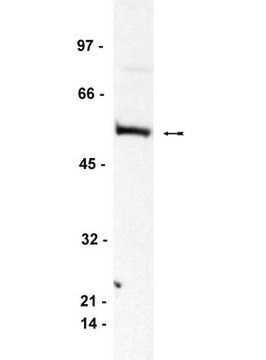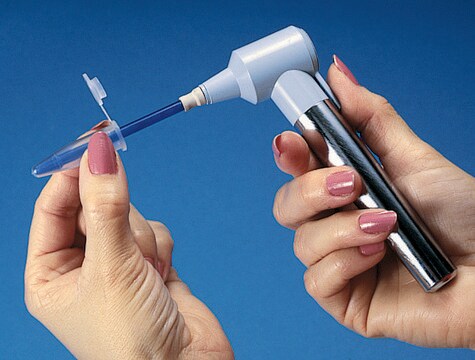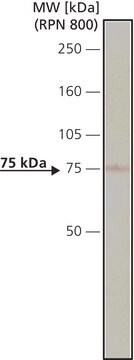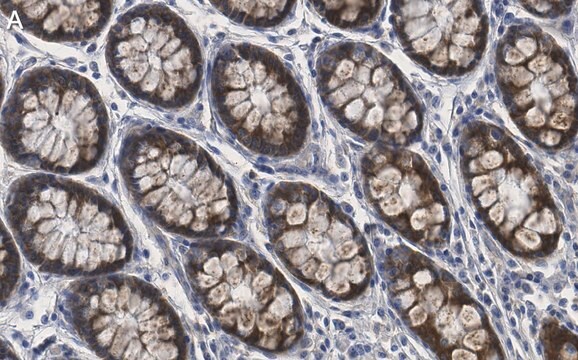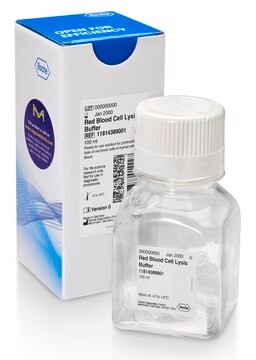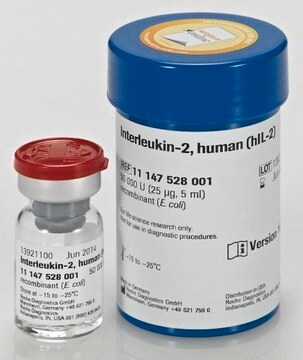一般說明
We are committed to bringing you greener alternative products, which adhere to one or more of The 12 Principles of Green Chemistry.This antibody is Preservative-free, produced without the harm or sacrifice of animals and exceptionally stable to allow for ambient shipping and storage if needed and thus aligns with "Waste Prevention", "Designing Safer Chemicals" and "Design for Energy Efficiency".
Click here for more information.
ZooMAb
® antibodies represent an entirely new generation of recombinant monoclonal antibodies.
Each ZooMAb
® antibody is manufactured using our proprietary recombinant expression system, purified to homogeneity, and precisely dispensed to produce robust and highly reproducible lot-to-lot consistency. Only top-performing clones are released for use by researchers. Each antibody is validated for high specificity and affinity across multiple applications, including its most commonly used application. ZooMAb
® antibodies are reliably available and ready to ship when you need them.
Learn more about ZooMAb here.特異性
Clone 99D.2 is a ZooMAb® mouse recombinant monoclonal antibody that specifically detects Myc box-dependent-interacting protein 1 (Bin1). It targets an epitope within the internal region.
免疫原
Recombinant fragment corresponding to 210 amino acids from the Internal region of human Myc box-dependent-interacting protein 1 (Bin1).
應用
Quality Control Testing
Evaluated by Western Blotting in C2C12 cell lysate.
Western Blotting Analysis: A 1:10,000 dilution of this antibody detected Bin1 in C2C12 cell lysate.
Tested applications
Western Blotting Analysis: A 1:10,000 dilution from a representative lot detected Bin1 in human skeletal muscle tissue lysate.
Immunocytochemistry Analysis: A 1:1,000 dilution from a representative lot detected Bin1 in C2C12 cells.
Immunohistochemistry (Paraffin) Analysis: A 1:100 dilution from a representative lot detected Bin1 in human cerebellum and human skeletal muscle tissue sections.
Flow Cytometry Analysis: 1 μg from a representative lot detected Bin1 in one million HeLa cells.
Note: Actual optimal working dilutions must be determined by end user as specimens, and experimental conditions may vary with the end user
Anti-Bin1, clone 99D.2 ZooMAb®, Cat. No. ZMS1067, is a recombinant Mouse monoclonal antibody that detects Bin1 and is tested for use in Flow Cytometry, Immunocytochemistry, Immunohistochemistry (Paraffin) and Western Blotting.
標靶描述
Myc box-dependent-interacting protein 1 (UniProt: O00499; also known as Amphiphysin II, Amphiphysin-like protein, Box-dependent myc-interacting protein 1, Bridging integrator 1, Bin1) is encoded by the BIN1 (also known as AMPHL) gene (Gene ID: 274) in human. Bin1 is a ubiquitous protein that displays highest expression levels in the brain and muscle. Eleven isoforms of Bin1 have been described that are generated by alternate splicing. These isoforms are translated into proteins differently in neurons and astrocytes. Cultured neurons mostly express isoforms 1,3,5, and 7 while cultured astrocytes express isoforms 2,5,9, and 10. Isoform IIA is reported to be expressed only in the brain where it is concentrated n axon initial segments and nodes of Ranvier. Bin1 contains one BAR domain (aa 29-276) and one SH3 domain (aa 520-592). Bin1 interacts with the functionally critical Myc box regions at the N- terminus of the MYC oncoprotein and inhibits MYC-induced malignant cell transformation. Hence, it is considered as a tumor suppressor. Mutations in BIN1 gene are known to cause centronuclear myopathy that is characterized by progressive muscular weakness and wasting involving mainly limb girdle, trunk, and neck muscles. This ZooMAb® recombinant monoclonal antibody, generated by our propriety technology, offers significantly enhanced specificity, affinity, reproducibility, and stability over conventional monoclonals. (Ref.: Taga, M., et al. (2020). Mol. Neurodegeneration. 15; Article 44).
外觀
Purified recombinant mouse monoclonal antibody IgG, lyophilized in PBS, 5% Trehalose, normal appearance a coarse or translucent resin. The PBS/trehalose components in the ZooMAb formulation can have the appearance of a semi-solid (bead like gel) after lyophilization. This is a normal phenomenon. Please follow the recommended reconstitution procedure in the data sheet to dissolve the semi-solid, bead-like, gel-appearing material. The resulting antibody solution is completely stable and functional as proven by full functional testing. Contains no biocide or preservatives, such as azide, or any animal by-products. Larger pack sizes provided as multiples of 25 μL.
重構
300 μg/mL after reconstitution at 25 μL per vial. Please refer to guidance on suggested starting dilutions and/or titers per application and sample type.
儲存和穩定性
Recommend storage of lyophilized product at 2-8°C; Before reconstitution, micro-centrifuge vials briefly to spin down material to bottom of the vial; Reconstitute each vial by adding 25 μL of filtered lab grade water or PBS; Reconstituted antibodies can be stored at 2-8°C, or -20°C for long term storage. Avoid repeated freeze-thaws.
法律資訊
ZooMAb is a registered trademark of Merck KGaA, Darmstadt, Germany
免責聲明
Unless otherwise stated in our catalog or other company documentation accompanying the product(s), our products are intended for research use only and are not to be used for any other purpose, which includes but is not limited to, unauthorized commercial uses, in vitro diagnostic uses, ex vivo or in vivo therapeutic uses or any type of consumption or application to humans or animals.

